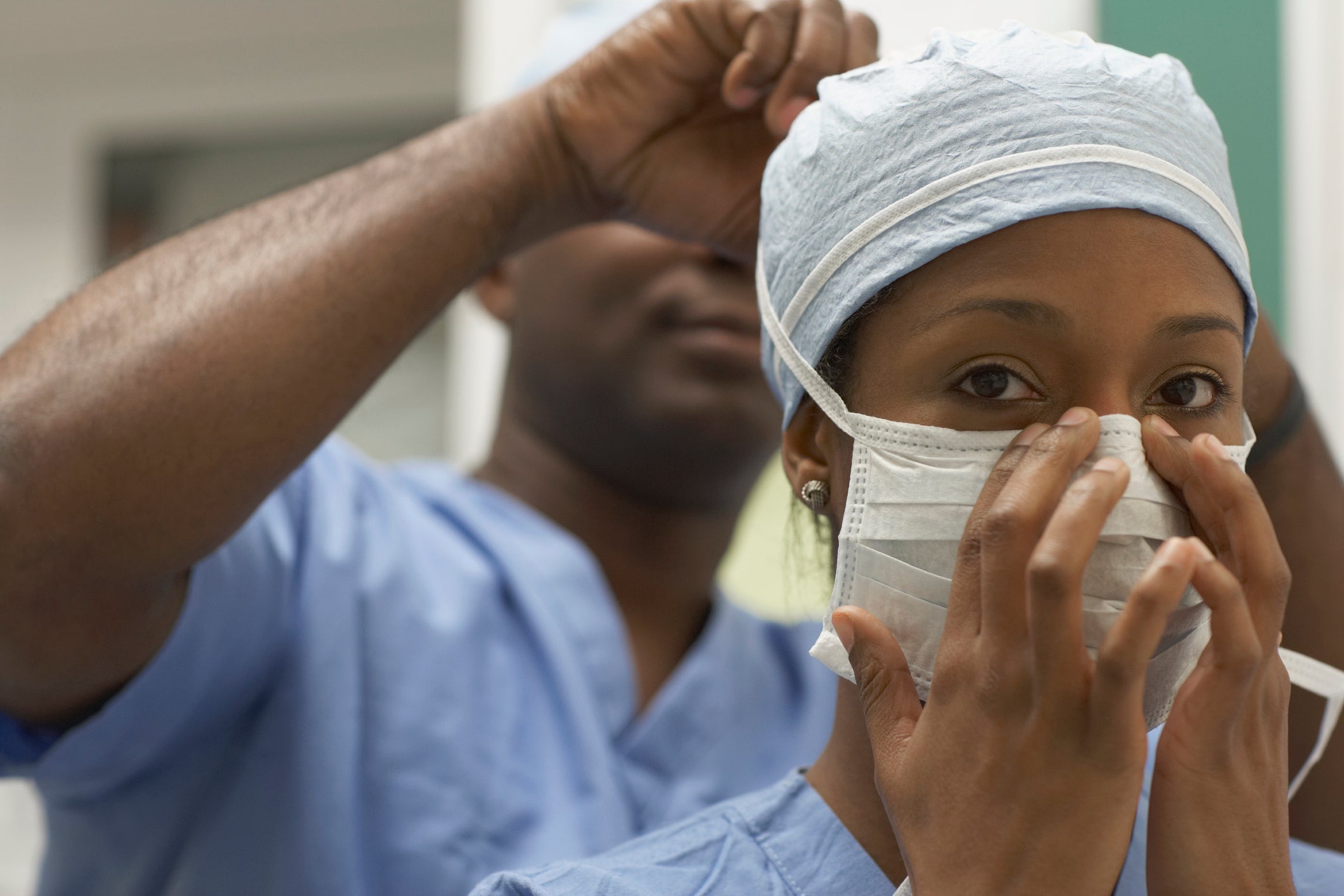They often leave their shifts to the sounds of applause. People line up in lobbies and on streets across the United States to cheer for them—to show gratitude for their service. At 7 p.m in Brooklyn, people across the borough open their windows and doors and clap for first responders. In midtown Atlanta, the praise begins at 8 p.m. In San Francisco, they’ve named their homage “Get Loud for Our Heroes.”
On the surface, this is a noble and worthy effort to acknowledge the risks doctors, nurses and other health care workers are taking every day to fight COVID-19, the illness caused by the novel coronavirus. But when I look at the faces of these doctors, nurses and other health care professionals at the center of this pandemic, I don’t see the same stony-around-the-edges pride and resolve we see on the faces of soldiers going off to war. What’s most evident in their faces is exhaustion. Dismay. Sadness. Frustration. It’s not just another day at the office for them. It’s another day of making hard decisions regarding who gets put on a ventilator and who can, hopefully, wait one more day. It’s another day of deciding whether they can wear a mask that, six months ago, they would have thrown away after 15 minutes, for another eight hours. It’s another day of intubating otherwise healthy 20-year-olds who didn’t believe social distancing was really necessary and are now fighting for their young, naive lives. Another day of calling a family who sent their loved ones by themselves to the hospital in an ambulance with a cough and fever, only to tell them that this same loved one died of a stroke—the newest fallout of COVID-19. Another day of feeling hopeless in the face of government ineptitude. Another day of possibly not going home to their own families in order to keep from potentially spreading the virus they are exposed to daily.
For Black health care workers, the stakes seem to be even higher. There is an acute awareness of the disparities that exist for Black and Brown folks who encounter COVID-19. There is the duality of absolutely holding space for every single victim of this disease, no matter who they are or where they come from, that must live alongside the knowledge that one of the most significant complications of COVID-19 is racism.
ESSENCE spoke exclusively to a number of Black doctors, nurses and health care professionals from around the country with the singular goal of learning and sharing what they are seeing and what they would want people to know about what’s happening on what’s often described as the “front lines.”
The Personal Sacrifices
When it comes to their own mental and emotional health, our health care workers are struggling. Jeri Crenshaw, a registered nurse and physician’s assistant based in Louisville, Kentucky, says, “I wrestle with ‘feeling dirty’ when I leave the hospital. I know I could carry this virus anywhere on me so I avoid my family and friends. The loneliness and isolation sometimes becomes unbearable, but I know the guilt I would feel if I spread the virus to one of them would be worse, so I tough it out. I feel angry that upper management is dictating how I protect myself. They dole out masks and other supplies based on availability rather than prevention of COVID-19. So, when leadership abandons best practices, you don’t know what to do. Do you demand they follow policy, to the extent that they’re able, threaten to quit or just make sure your will is updated?”
Savoy Brummer, M.D., emergency room doctor, vice-president of Vituity, and a member of the board of trustees of the Emergency Foundation in Los Angeles, says, “I’m mentally exhausted. On one hand, as a physician, I deal with both the risk to me and my family each time I go to the hospital. However, I also have the additional responsibility of ensuring the safety of thousands of physicians and nurses and hundreds of thousands ER patients. Instead of ‘Netflix and Chill,’ my late nights typically include consoling immediate and extended family, answering the questions of friends and responding to nurses and physicians expressing concerns about their work environment. I literally do not have enough hours in the day to respond to everyone. What’s most devastating to my soul is learning of colleagues and friends, front line workers I’ve known for years, contracting or even dying from this virus. It’s a lot to digest in the setting of a quarantine.”
Allie Henderson-Fitts, M.D., an internal medicine doctor at TVHS division of Veterans Affairs in Nashville, describes her state of mind as “a sense of helplessness.” There is this sense that the lack of resources has created the bulk of the ordeal for Black people. “It’s knowing what needs to be done based on data, but being unable to do anything based on availability of resources for your patient population,” Henderson-Fitts says.
The Balancing Act
For some, the threats of COVID-19 extend to their own homes and families. Like many of us, they also have to balance children who are now home from school and confused. Wyniqua Brown, a nurse practitioner for Einstein Hospitals in Philadelphia, shared her concern about working in telemedicine while raising children: “As an outpatient nurse practitioner, my employer has provided a way to engage and care for patients virtually. Telemedicine provides a safe way during this time to care for patients in the comfort and safety of their homes. But I wrestle with several issues. As a single mother raising two school age children, the burden of homeschooling is on my plate. Although my district has provided the computers and a simple way to [implement] distance learning it is still a daily challenge for me. I am seeing patients daily and I have to be able to multitask and be a teacher, too.”
Henderson-Fitts notes a different challenge. “There is a frustration with the unknown. My son is a graduating high school senior and I can’t answer any of his questions: ‘Will I get to walk across the stage? Will college start on-campus in the fall?’ ”
These Are Our People
Part of the personal anguish Black health care professionals experience is rooted in the disturbing things they encounter daily as they do their work. Crenshaw says that the most devastating part of her experience is the “ever-changing classification of what constitutes appropriate personal protection equipment (PPE). It literally changes from day to day.” Brummer agrees: “Unfortunately, the federal government has not provided a mechanism for PPE to be distributed to the doctors that need them the most. The hospitals in neighborhoods and communities that serve urban Black communities are not as resourced as the hospitals in the suburbs.You’ve seen this in Detroit and Houston. Moreover, testing has been especially difficult in low-income communities. There is an underestimation of cases in those communities because testing is not available.”

Brummer also has concerns around how Black people have responded to the virus. “The original communication from the U.S. government was that this disease affects older people with preexisting conditions. Accordingly, many younger and middle-age Black people were not vigilant about the quarantine. Rumors immediately began that Black people were immune from contracting the disease. To a large extent, Black folks who have lived through slavery, malaria and HIV felt that a virus like this was not nearly as dangerous as previous threats. However, what we are seeing now is the opposite—the Black community is more likely than any other to be hospitalized and die after contracting the disease.
“Most important, I see young to middle-age Black people with no preexisting conditions in their thirties and forties that are placed on breathing machines and die from respiratory failure,” Brummer continues. “Also, Black households are more likely to have multigenerational living situations under one roof and so kids [who can be asymptomatic] not only infect their parents but also their grandparents.”
One of Brummer’s observations seems to bear out in the coverage of the virus so far. “This virus tends to generate bad outcomes in Black men almost twice as much as Black women,” he says. “This is likely due to some of the protective immunological genes on the X chromosome.”
The revealing of long-existing health disparities created by entrenched health discrimination are equally crushing. “People of color, especially Black people, have been getting a raw deal from the medical community for years,” Crenshaw says. “Thus, they’re more likely to have the comorbid conditions that increase their susceptibility to this virus. Access to care, not genetics as is often touted in scientific literature, leaves these patients inadequately treated and vulnerable. Ask the average Black person with COPD or asthma how many times their provider has brushed their shortness of air off as normal rather than an exacerbation of their condition and you will understand why they’re more likely to be intubated and in critical condition with COVID-19. [Then there is] one of the biggest indicators of health disparities for minorities—hypertension. Providers are more likely to focus on treatment of this condition rather than prevention in Black people and even when doing so they’re often lax on how tightly they control it.”
Henderson Fitts cosigns this: “Access to care [is a challenge for these patients]. The clinics closest to them weren’t testing, their symptoms weren’t believed, or even worse, were downplayed. [There’s also] a lack of advocacy. Middle- class Black people were turned away not because they didn’t have insurance, not because they were asymptomatic, but because people could turn them away and there was nobody there to fight for them.”

Rosie Chaney, a registered nurse in Long Beach, California, believes that the biggest issue is exactly around this “turning people away” that we’ve seen. “Should we test everyone who walks in the door of the hospital? Yes,” she says. “At least we can see if inpatients are positive or not. Setting up the “drive up” testing stations can help, however, the results are only good for that date. The two hospitals I work in are both in underserved communities. In the areas where I work, Blacks, Latinos, Asians and Whites all have the same opportunity to at least get seen in the emergency room, [but] whether they receive follow-up care sometimes depends on resources provided to them.”
We’re All We Got
At the end of the day, Black health care professionals are doing everything possible to fill in the gaps of those disparities. Brummer says, “The media traditionally displays images of White government and medical officials who are providing the direction and leadership of this crisis. However, many of the people who are actually providing the institutional leadership are Black physicians, pharmacists, nurses and advanced providers. Black physicians, traditional leaders in Black communities, will remain committed and will not allow our communities suffering to remain silent.”
And now with strokes being something we are seeing affect people of color in their thirties and forties, there is more reason for vigilance. Brummer is especially adamant on this. “The most effective treatment for strokes in emergency medicine occurs within the first three hours of symptom onset. We have to educate young and middle-age minorities about the signs and symptoms of strokes and that they need to come immediately into the hospital for treatment.”
It’s a distinctly American way of approaching a crisis, isn’t it? To cheer and rah-rah ourselves into oblivion. To underestimate our opponent. To declare war and name heroes yet continue to accept (and vote) for the status quo that made us vulnerable in the first place. But we’re certain that nearly every first responder we spoke with would gladly trade that applause for the actual resources to make his or her job less taxing: access to PPE, more testing availability and real advancement toward some kind of solution that doesn’t solely serve Big Pharma.
They are pleading with us to lay down our entitlements and our conspiracy theories. They are begging everyone to throw away our notions of who is worthy of living and dying—because those lines are becoming more and more blurry as the days go on.
—
ESSENCE is committed to bringing our audience the latest facts about COVID-19 (coronavirus). Our content team is closely monitoring the developing details surrounding the virus via official sources and health care experts, including the World Health Organization (WHO), the Centers for Disease Control and Prevention (CDC) and the Occupational Safety and Health Administration (OSHA). Please continue to refresh ESSENCE’s informational hub for updates on COVID-19, as well as for tips on taking care of yourselves, your families and your communities.
